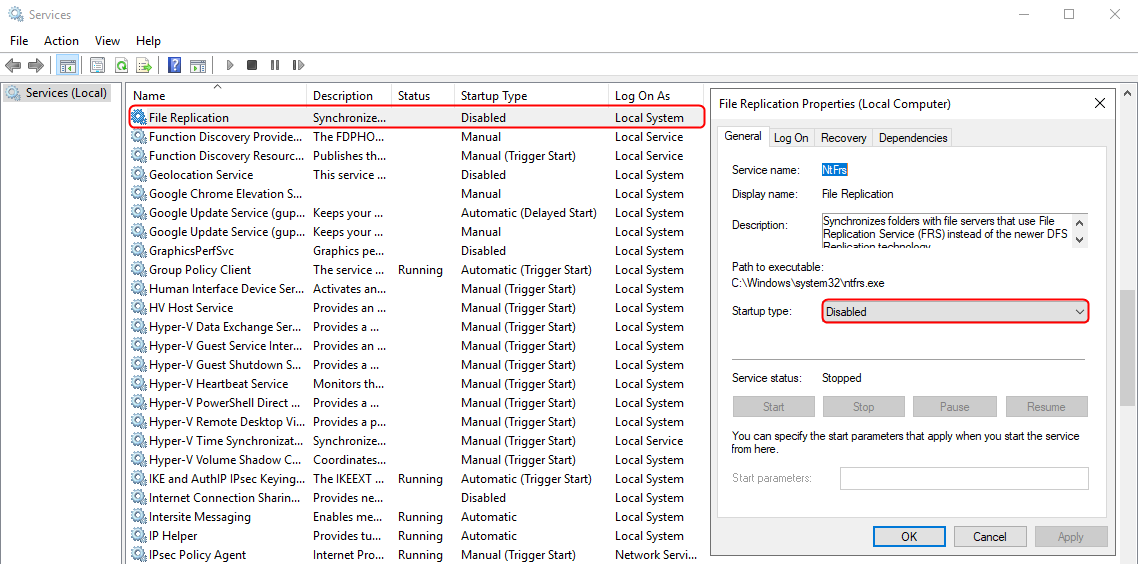SYSVOL FRS to DFSR Migration
DISCLAIMER: The information in this guide is provided "as is" without any guarantee of completeness, accuracy, timeliness, or of the results obtained from the use of this information. The author assumes no responsibility for any errors or omissions in the content. It is meant for general information purposes only and should not be used as a substitute for professional advice. The author is not responsible for any damages caused by the use of this information. By using this guide, you agree to hold the author harmless from any and all claims, damages, or expenses that may arise from your use of the information.
Introduction
Applies to: Windows Server 2022, Windows Server 2019, Windows Server 2016, Windows Server 2012 R2, Windows Server 2012, Windows Server 2008 R2, Windows Server 2008
DFS Replication is a role service in Windows Server that enables you to efficiently replicate folders (including those referred to by a DFS namespace path) across multiple servers and sites. DFS Replication is an efficient, multiple-master replication engine that you can use to keep folders synchronized between servers across limited bandwidth network connections. It replaces the File Replication Service (FRS) as the replication engine for DFS Namespaces. [...]Active Directory Domain Services (AD DS) uses DFS Replication for replicating the SYSVOL folder in domains that use the Windows Server 2008 or later domain functional level.
DFS Replication uses a compression algorithm known as remote differential compression (RDC). RDC detects changes to the data in a file and enables DFS Replication to replicate only the changed file blocks instead of the entire file.
SOURCE: https://learn.microsoft.com/en-us/windows-server/storage/dfs-replication/dfsr-overview
Requirements
- Update the Active Directory Domain Services (AD DS) schema to include Windows Server 2003 R2 or later schema additions. You cannot use read-only replicated folders with the Windows Server 2003 R2 or older schema additions.
- Ensure that all servers in a replication group are located in the same forest. You cannot enable replication across servers in different forests.
- Install DFS Replication on all servers that will act as members of a replication group.
- Contact your antivirus software vendor to check that your antivirus software is compatible with DFS Replication.
- Locate any folders that you want to replicate on volumes formatted with the NTFS file system. DFS Replication does not support the Resilient File System (ReFS) or the FAT file system. DFS Replication also does not support replicating content stored on Cluster Shared Volumes.
Verify If FRS or DFS Is in Use
If using a functional level of 2008 or higher, check to see if FRS is running, or if a migration to DFS has already been completed.
Open the CMD prompt or PowerShell and run the following command:
Dfsrmig /getglobalstate
FRS is still running if the output states “DFSR Migration has not yet initialized. To start migration please set global state to desired value”. The global state values and their respective descriptions are included below:
| Global State | Description |
| State 0: Start |
FRS will replicate the SYSVOL folder between all of the active domain controllers. |
| State 1: Prepared |
In this state, DFSR will replicate a copy of SYSVOL folder. The default location is: %SystemRoot%\SYSVOL_DFRS |
| State 2: Redirected |
In this state the DFSR copy of SYSVOL will be made the primary SYSVOL and will start responding to SYSVOL service requests. FRS will continue the replication of its own SYSVOL copy, but will not be used. |
| State 3: Eliminated |
In this state, Windows will delete the original SYSVOL folder used by FRS and then stop the FRS service. DFS will continue replicating and responding to requests. |
Instructions
The following steps will be used on a functional Domain Controller. Open the CMD prompt or PowerShell.
- Migrate to the prepared state (1):
Dfsrmig /setglobalstate 1The migration can take 15min to 1 hour to complete, this depends on your AD replication time. You can force this by running the following command after each state change:
Repadmin /syncall /force /APed - Verify all domain controllers have reached the prepared state:
Dfsrmig /getmigrationstateWhen running
Dfsrmig /getmigrationstateyou will receive a similar message after each successful global state migration:
All domain Controllers have migrated successfully to Global sate ('<State Name>').
Migration has reached a consistent state on all Domain Controllers.
Succeeded. - Migrate to Redirected State (2)
Dfsrmig /setglobalstate 2 - Verify all domain controllers have reached the redirected state:
Dfsrmig /getmigrationstate - Migrate to the Eliminated State (3rd and final)
Dfsrmig /setglobalstate 3 - Verify all domain controllers have reached the eliminated state:
Dfsrmig /getmigrationstate - Login to each domain controller and verify the "NtFrs" service is stopped and disabled.
Sources
KB Change/Issue Log
yyyy/mm/dd - Title
Issue
N/A
Solution
N/A
KB Meta
| Page Includes | @9#bkmrk-callout-danger-NoResponsibilityDisclaimer-5wod5ufe |






